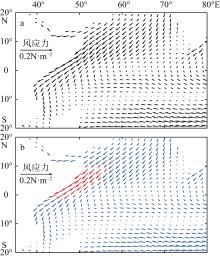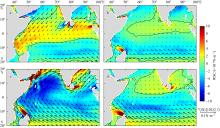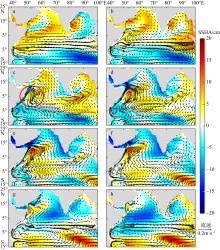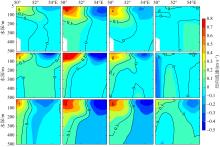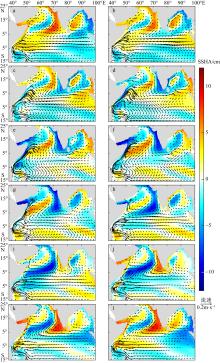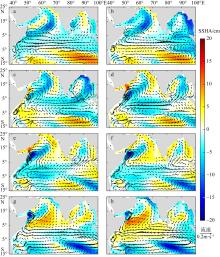| [1] |
陈更新, 2022. 链接热带东印度洋环流的海洋波动桥梁[J]. 地球科学进展, 37(1): 80-86.
doi: 10.11867/j.issn.1001-8166.2021.113
|
|
CHEN GENGXIN, 2022. The ocean wave bridge linking the circulation in the tropical Eastern Indian Ocean[J]. Advances in Earth Science, 37(1): 80-86. (in Chinese with English abstract)
doi: 10.11867/j.issn.1001-8166.2021.113
|
| [2] |
ANDERSON D L T, MOORE D W, 1979. Cross-equatorial inertial jets with special relevance to very remote forcing of the Somali Current[J]. Deep Sea Research Part A. Oceanographic Research Papers, 26(1): 1-22.
doi: 10.1016/0198-0149(79)90082-7
|
| [3] |
BALMASEDA M A, TRENBERTH K E, KÄLLÉN E, 2013. Distinctive climate signals in reanalysis of global ocean heat content[J]. Geophysical Research Letters, 40(9): 1754-1759.
doi: 10.1002/grl.v40.9
|
| [4] |
CHAMBERLAIN M A, OKE P R, FIEDLER R A S, et al, 2021. Next generation of Bluelink ocean reanalysis with multiscale data assimilation: BRAN2020[J]. Earth System Science Data, 13(12): 5663-5688.
doi: 10.5194/essd-13-5663-2021
|
| [5] |
CHEN GENGXIN, HAN WEIQING, LI YUANLONG, et al, 2015. Seasonal-to-interannual time-scale dynamics of the Equatorial Undercurrent in the Indian Ocean[J]. Journal of Physical Oceanography, 45(6): 1532-1553.
doi: 10.1175/JPO-D-14-0225.1
|
| [6] |
CHEN GENGXIN, HAN WEIQING, LI YUANLONG, et al, 2016. Interannual variability of equatorial eastern Indian Ocean upwelling: local versus remote forcing[J]. Journal of Physical Oceanography, 46(3): 789-807.
doi: 10.1175/JPO-D-15-0117.1
|
| [7] |
CHEN GENGXIN, HAN WEIQING, LI YUANLONG, et al, 2017. Strong intraseasonal variability of meridional currents near 5°N in the eastern Indian Ocean: characteristics and causes[J]. Journal of Physical Oceanography, 47(5): 979-998.
doi: 10.1175/JPO-D-16-0250.1
|
| [8] |
CHEN GENGXIN, HAN WEIQING, LI YUANLONG, et al, 2019. Intraseasonal variability of the equatorial undercurrent in the Indian Ocean[J]. Journal of Physical Oceanography, 49(1): 85-101.
doi: 10.1175/JPO-D-18-0151.1
|
| [9] |
CHEN GENGXIN, HAN WEIQING, ZHANG XIAOLIN, et al, 2020. Determination of spatiotemporal variability of the Indian Equatorial Intermediate Current[J]. Journal of Physical Oceanography, 50(11): 3095-3108.
doi: 10.1175/JPO-D-20-0042.1
|
| [10] |
CHEN GENGXIN, PENG QIHUA, HUANG RUIXIN, et al, 2022. A time-dependent Sverdrup relation and its application to the Indian Ocean[J]. Journal of Physical Oceanography, 52(6): 1233-1244.
doi: 10.1175/JPO-D-21-0223.1
|
| [11] |
COX M D, 1979. A numerical study of Somali Current eddies[J]. Journal of Physical Oceanography, 9(2): 311-326.
doi: 10.1175/1520-0485(1979)009<0311:ANSOSC>2.0.CO;2
|
| [12] |
HURLBURT H E, THOMPSON J D, 1976. A numerical model of the Somali Current[J]. Journal of Physical Oceanography, 6(5): 646-664.
doi: 10.1175/1520-0485(1976)006<0646:ANMOTS>2.0.CO;2
|
| [13] |
LEETMAA A, 1972. The response of the Somali Current to the southwest monsoon of 1970[J]. Deep Sea Research and Oceanographic Abstracts, 19(4): 319-325.
doi: 10.1016/0011-7471(72)90025-3
|
| [14] |
LEETMA A, 1973. The response of the Somali Current at 2°S to the southwest monsoon of 1971[J]. Deep Sea Research and Oceanographic Abstracts, 20(4): 397-400.
doi: 10.1016/0011-7471(73)90062-4
|
| [15] |
LI YUANLONG, HAN WEIQING, SHINODA T, et al, 2014. Revisiting the wintertime intraseasonal SST variability in the tropical south Indian Ocean: Impact of the ocean interannual variation[J]. Journal of Physical Oceanography, 44(7): 1886-1907.
doi: 10.1175/JPO-D-13-0238.1
|
| [16] |
LI YUANLONG, HAN WEIQING, WANG WANQIU, et al, 2017. Bay of Bengal salinity stratification and Indian summer monsoon intraseasonal oscillation: 2. Impact on SST and convection[J]. Journal of Geophysical Research: Oceans, 122(5): 4312-4328.
doi: 10.1002/jgrc.v122.5
|
| [17] |
LIGHTHILL M J, 1969. Dynamic response of the Indian Ocean to onset of the southwest monsoon[J]. Philosophical Transactions of the Royal Meteorological Society A, 265(1159): 45-92.
|
| [18] |
LUTHER M E, O’BRIEN J J, 1985. A model of the seasonal circulation in the Arabian Sea forced by observed winds[J]. Progress in Oceanography, 14: 353-385.
doi: 10.1016/0079-6611(85)90017-5
|
| [19] |
MCCREARY J P, KUNDU P K, 1985. Western boundary circulation driven by an alongshore wind: with application to the Somali Current system[J]. Journal of Marine Research, 43(3): 493-516.
doi: 10.1357/002224085788440385
|
| [20] |
MCCREARY J P, KUNDU P K, 1988. A numerical investigation of the Somali Current during the Southwest Monsoon[J]. Journal of Marine Research, 46(1): 25-58.
doi: 10.1357/002224088785113711
|
| [21] |
OKE P R, BRASSINGTON G B, GRIFFIN D A, et al, 2008. The Bluelink ocean data assimilation system (BODAS)[J]. Ocean Modelling, 21(1-2): 46-70.
doi: 10.1016/j.ocemod.2007.11.002
|
| [22] |
PHILANDER G, DELECLUSE P, 1983. Coastal currents in low latitudes (with application to the Somali and El Niño Currents)[J]. Deep Sea Research Part A. Oceanographic Research Papers, 30(8): 887-902.
doi: 10.1016/0198-0149(83)90006-7
|
| [23] |
QIU YUN, LI LI, YU WEIDONG, 2009. Behavior of the Wyrtki Jet observed with surface drifting buoys and satellite altimeter[J]. Geophysical Research Letters, 36(18). DOI: 10.1029/2009gl039120.
doi: 10.1029/2009gl039120
|
| [24] |
SCHOTT F A, MCCREARY J P, 2001. The monsoon circulation of the Indian Ocean[J]. Progress in Oceanography, 51(1): 1-123.
doi: 10.1016/S0079-6611(01)00083-0
|
| [25] |
WANG JING, YUAN DONGLIANG, ZHAO XIA, 2017. Impacts of Indonesian Throughflow on seasonal circulation in the equatorial Indian Ocean[J]. Chinese Journal of Oceanology and Limnology, 35(6): 1261-1274.
doi: 10.1007/s00343-017-6196-0
|
| [26] |
YUAN DONGLIANG, HAN WEIQING, 2006. Roles of equatorial waves and Western boundary reflection in the seasonal circulation of the equatorial Indian ocean[J]. Journal of Physical Oceanography, 36(5): 930-944.
doi: 10.1175/JPO2905.1
|
 ), PENG Qihua3
), PENG Qihua3


